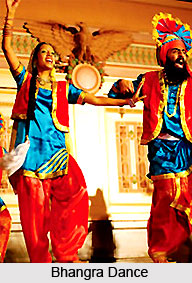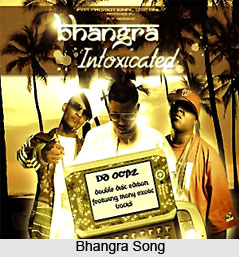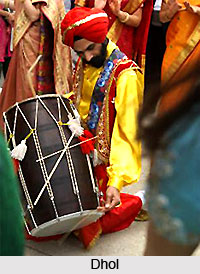 Bhangra is a form of music and dance that has its origins in the Punjab region of Pakistan and India. Bhangra dance began as a folk culture conducted by farmers to celebrate the coming of spring, a time known to be the Vaisakhi time. Today, bhangra survives in different forms and styles all over the world, including pop music, film soundtracks, and even competitions in colleges.
Bhangra is a form of music and dance that has its origins in the Punjab region of Pakistan and India. Bhangra dance began as a folk culture conducted by farmers to celebrate the coming of spring, a time known to be the Vaisakhi time. Today, bhangra survives in different forms and styles all over the world, including pop music, film soundtracks, and even competitions in colleges.
The origin of Bhangra owes to the Vaisakhi festival celebrations of Punjabis and found its way to the stage performances after the division of the Punjab in 1947. The Punjabi dance performed at this time in delight with the beat of Dhol was given the formal name as Bhangra. The tradition spread slowly to other parts of the state and developed into a unique folk dance form in India. Bhangra has become a tradition and is now performed at every major celebration and in clubs etc.
Traditional Bhangra is a fusion of upbeat music, singing and the beat of the dhol drum, a single stringed instrument called the iktar (ektara), the tumbi and the chimta. The Bhangra songs that accompany the dance celebrations are small couplets written in the Punjabi language called bolis. These bolis relate to current issues faced by the singers and what they truly want to say about their culture. In Punjabi folk music, the dhol`s smaller cousin, the dholki is frequently used to provide the main beat. However, in recent days the dhol is used more frequently, with and without the dholki. Extra percussion, including tabla, is not much used in bhangra as a solo instrument but is sometimes used along with the dhol and dholki. The dholki drum patterns in Bhangra songs put up with an intimate similarity to the rhythms in Reggae music. This rhythm is a common thread which allows for easy union between Bhangra and Reggae as demonstrated by such artists as the UK`s Apache Indian.
During the last thirty years, Bhangra music has enjoyed the peak in popularity worldwide, both in traditional form and as a fusion with genres of music such as hip-hop, house, and reggae. In the late 1960s and 1970s, several Punjabi singers from the United Kingdom prepared the stage for Bhangra so that it can become a mass phenomenon. The singers/bands/artists related to Bhangra music include Jatinder Dhol Group, Kuldip Manak, the band heera, the band Alaap, A.S. Kang and others.

Major migrations of Punjabis to the Britain took the Bhangra music in the foreign land during the 1980s. Bhangra dancing was originally perceived as a male dance along with a "man`s song", with strong, passionate movements. However, later the women have increasingly started dancing bhangra and portrayed it as a way of defining cultural identity. In the 1980`s Bhangra artists were selling over 30,000 cassettes a week.
The 1980s is commonly known as the golden age or the `Punkra` era. This period lasted roughly from 1985 to 1993, the primary stress during these times was on the melody or riff, played out usually on a synthesizer, harmonium, accordian or a guitar.
One of the biggest Bhangra stars is Malkit Singh and is known as "the golden voice of the Punjab". His group - Golden Star is also one of the reputed bands of the state. Gurdas Mann is a multi-talented Punjabi singer and had a huge impact on Bhangra music. He started his career in 1980 with his first album, Dil Da Mamla, which followed by his huge hit Masti, musically directed by Charanjit Ahuja. Charanjit Ahuja changed the sound of Punjabi music in India, using non-ethnic instruments such as Spanish guitars, saxophone and trumpet (punkra). Since then Gurdas Maan has become an idol for many, not only for his lyrical and musical talent, but also his enacting ability.

The group Alaap with the lead as Channi Singh is also a popular Bhangra group in Punjab. Heera, formed by Bhupinder Bhindi and lead by Kumar and Dhami, was one of the most popular bands of the eighties. Bands such as "Alaap" and "Heera" included Rock influenced beats into Bhangra. Several other significant groups appeared around the same time period, including Bhujungy Group, The Saathies and Apna Sangeet. Apna Sangeet, most famously known for their hit Mera Yaar Vajavey Dhol, are still performing and are known as one of the best live acts in Bhangra.
Bhangra took large steps toward conventional integrity in the 1990s, especially among youths. At the beginning of the nineties, many artists came back to the original, folk beats of Bhangra, often incorporated more dhol drum beats and tumbi. This time also saw the growth of several young Punjabi singers. The most influential champion of the new "folk hop" was the band called "Canadian folkster", Jazzy Bains.
Bhangra is also heavily influenced by the combination of some guitar with hip-hop beats. Each of their songs relates to some importance in the world of the Asian culture. Other leading Bhangra artists include Surinder Shinda, Harbhajan Mann, Manmohan Waris, Meshi Eshara, Sarbjit Cheema, Hans Raj Hans, Sardool Sikander, Sahotas, Geet the Mega Band, Anakhi, Sat Rang, XLNC, B21, Shaktee, Intermix, Sahara, Paaras, PDM, DCS, Amar Group, Sangeet Group, Bombay Talkie and others.
Bhangra lyrics are always in the Punjabi language; they generally cover social issues such as love, relationships, money, dancing, getting drunk and marriage. Moreover, there are innumerable Bhangra songs dedicated to Punjabi pride themes and Punjabi heroes. The lyrics are accolades to the rich enriching traditions of the Punjabis. In particular, many Bhangra songs have been written about Udham Singh and Bhagat Singh.
Bhangra singers do not sing in the same tone of voice as their Southeast Asian counterparts. They employ a high, vigorous tone of voice. Singing fiercely, and with great pride, they typically add random noises to their singing. Likewise, often people dancing to Bhangra start yelling phrases such as hey hey hey, balle balle, oye oye, buurrraaa, haripa or ch-ch to the music.




















